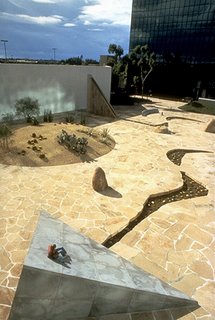Einstein, Noguchi, and Buckminster Fuller - or - What's A Little Art, History, War, Politics and Science Between Friends?

In 1986 I drove up to Costa Mesa California with some classmates and a professor to view a courtyard.
You read that right.
To be fair, it was a large courtyard. But yes, we went there specifically to see it, only.
Isamu Noguchi produced plazas and playgrounds, sculptures of stone, metal, water, paper and wood. And ceilings. And furniture, and light fixtures. And theatre sets. He was prolific, and his career spanned something like 70 years plus.
This post is not about Noguchi necessarily. Another post, another time.
This post is about that serendipitous confluence of people and events that in this instance just kind of tickled me.
That's what the internet is for, right? Trivial happenstance, regifted.
A Western Union Telegram in 1936 was effectively the internet email of the time, where you could fabulously pass a message cross country in the blink of an eye. This was modern science at its dutiful best, in the heady days before the second world war when modern science would be bent into ghastly shapes and unthinkable temperatures.
But the sheen of modern science and the World's Fairs that flaunted it, was blinding. Political and economic issues of poverty and the nature of work, of enslavement and ideology, exploitation and national advancement, all were conspiring to plunge the world into a war of epic proportions. In 1936, in America the Depression had flattened much of the decade for the average person, but the end of bad times was somewhat in sight. Things were progressing, science was enlightening, business was continuing, and people were working, at least.
Europe, however was slipping into mad nationalistic terror. Japan was running rampant over the Far East in wars over natural resources and human labor.
Russia and Mexico and a number of other nations were just coming out of a decade where the nature of work and community were being explored in whole new ways. I say "coming out" of that decade when really I mean spiraling down off the tower, dropping directly into a decade of dictatorship and terror that would crash headlong into opposing ideologies and powerful war machines of another constitution altogether.
In 1936, Isamu Noguchi was a young artist and designer doing his first large public mural, in Mexico. Fifty years later I went to walk around a bank building plaza called "California Scenario" where Noguchi's favored thematic mixture of nature and technology was expressed so elegantly you'd hardly get the impression that his career was born in the turbulence of a world at war with itself.
bookofjoe.com pulled up, from somewhere, a copy of a 1936 Western Union telegram from Buckminster Fuller to Isamu Noguchi, responding to a question Noguchi had while working on his first large public sculpture. Noguchi wanted to get clarification on Albert Einstein's equation for energy so he could include it in his panoramic political piece.
The reply from Fuller is a piece of word artistry in itself. Try to imagine reducing the Theory of Relativity to a telegram. From bookofjoe's site:
...a finite value for basic factor in motion universe stop speed of radiant energy being directional outward all directions expanding wave surface diametric polar speed away from self is twice speed in one direction and speed of volume increase is square of speed in one direction approximately thirty five billion volumetric miles per second stop
Ultimately all Noguchi wanted was to include e=mcsquared in his piece, to symbolize the new and fabulous world that the new generations in Mexico and Italy and everywhere were to discover going forward in 1936. Of course, Noguchi's interest has always been the precarious balance between the better parts of nature and human technology and this elegant opposition could be seen even in his first political piece in the calm before the storm.
I find it fascinating that just a few years after Noguchi and Fuller discussed Einstein's equation, the fury of atomic fission would abruptly end the war between the U.S. and Japan. Actually, that's not the fascinating part. The fascinating part is that this is such a fine example of the overlapping and intertwining elements of art and science and politics and history.
Yes. That's the fascinating part.
strolling plaza of sandstone water metal stone STOP mountains rivers deserts represented includes pine trees fountains STOP Isamu Noguchi designed STOP glad to see it - time to go home and study STOP
bookofjoe: Buckminster Fuller explains Einstein's theory of relativity in a telegram to Isamu Noguchi

0 Comments:
Post a Comment
<< Home